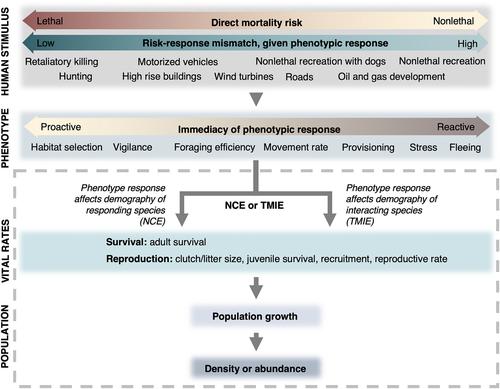当前位置:
X-MOL 学术
›
Ecol. Lett.
›
论文详情
Our official English website, www.x-mol.net, welcomes your
feedback! (Note: you will need to create a separate account there.)
Population and community consequences of perceived risk from humans in wildlife
Ecology Letters ( IF 7.6 ) Pub Date : 2024-06-22 , DOI: 10.1111/ele.14456 Justine A. Smith 1 , Megan E. McDaniels 1 , Scott D. Peacor 2 , Ellen C. Bolas 1 , Michael J. Cherry 3 , Nathan J. Dorn 4 , Olivia K. Feldman 1 , David L. Kimbro 5 , Emily K. Leonhardt 1 , Nicole E. Peckham 5 , Michael J. Sheriff 6 , Kaitlyn M. Gaynor 7
Ecology Letters ( IF 7.6 ) Pub Date : 2024-06-22 , DOI: 10.1111/ele.14456 Justine A. Smith 1 , Megan E. McDaniels 1 , Scott D. Peacor 2 , Ellen C. Bolas 1 , Michael J. Cherry 3 , Nathan J. Dorn 4 , Olivia K. Feldman 1 , David L. Kimbro 5 , Emily K. Leonhardt 1 , Nicole E. Peckham 5 , Michael J. Sheriff 6 , Kaitlyn M. Gaynor 7
Affiliation

|
Human activities catalyse risk avoidance behaviours in wildlife across taxa and systems. However, the broader ecological significance of human‐induced risk perception remains unclear, with a limited understanding of how phenotypic responses scale up to affect population or community dynamics. We present a framework informed by predator–prey ecology to predict the occurrence of non‐consumptive effects (NCE) and trait‐mediated indirect effects (TMIE) of anthropogenic disturbances. We report evidence from a comprehensive review of the different types of human‐induced behavioural and physiological phenotypic changes and their influence on vital rates and population parameters in wildlife. Evidence for human‐induced NCEs and TMIEs is mixed, with half of published studies finding a relationship between human activities, phenotypic change and population outcomes. The net effects of anthropogenic NCEs and TMIEs depend on the mismatch between the phenotypic response and the lethality of human activity. However, strong research biases in taxa, systems, human disturbance types and demographic measures prevent unified inference about the prevalence of population responses to human activities. Coexistence with and conservation of wildlife requires additional research linking human‐induced phenotypic change to population and community outcomes.
中文翻译:

人类对野生动物的感知风险对人口和社区的影响
人类活动促进野生动物跨类群和系统的风险规避行为。然而,人类引起的风险感知的更广泛的生态意义仍不清楚,对表型反应如何扩大影响种群或群落动态的了解有限。我们提出了一个以捕食者-被捕食者生态学为基础的框架来预测人为干扰的非消耗效应(NCE)和性状介导的间接效应(TMIE)的发生。我们报告了对不同类型的人类引起的行为和生理表型变化及其对野生动物生命率和种群参数的影响的全面审查的证据。人类诱发的 NCE 和 TMIE 的证据是混杂的,一半已发表的研究发现人类活动、表型变化和人口结果之间存在关系。人为 NCE 和 TMIE 的净效应取决于表型反应与人类活动致死率之间的不匹配。然而,在类群、系统、人类干扰类型和人口统计指标方面存在强烈的研究偏差,无法对人口对人类活动反应的普遍程度进行统一推断。与野生动物的共存和保护需要更多的研究,将人类引起的表型变化与人口和社区结果联系起来。
更新日期:2024-06-22
中文翻译:

人类对野生动物的感知风险对人口和社区的影响
人类活动促进野生动物跨类群和系统的风险规避行为。然而,人类引起的风险感知的更广泛的生态意义仍不清楚,对表型反应如何扩大影响种群或群落动态的了解有限。我们提出了一个以捕食者-被捕食者生态学为基础的框架来预测人为干扰的非消耗效应(NCE)和性状介导的间接效应(TMIE)的发生。我们报告了对不同类型的人类引起的行为和生理表型变化及其对野生动物生命率和种群参数的影响的全面审查的证据。人类诱发的 NCE 和 TMIE 的证据是混杂的,一半已发表的研究发现人类活动、表型变化和人口结果之间存在关系。人为 NCE 和 TMIE 的净效应取决于表型反应与人类活动致死率之间的不匹配。然而,在类群、系统、人类干扰类型和人口统计指标方面存在强烈的研究偏差,无法对人口对人类活动反应的普遍程度进行统一推断。与野生动物的共存和保护需要更多的研究,将人类引起的表型变化与人口和社区结果联系起来。































 京公网安备 11010802027423号
京公网安备 11010802027423号